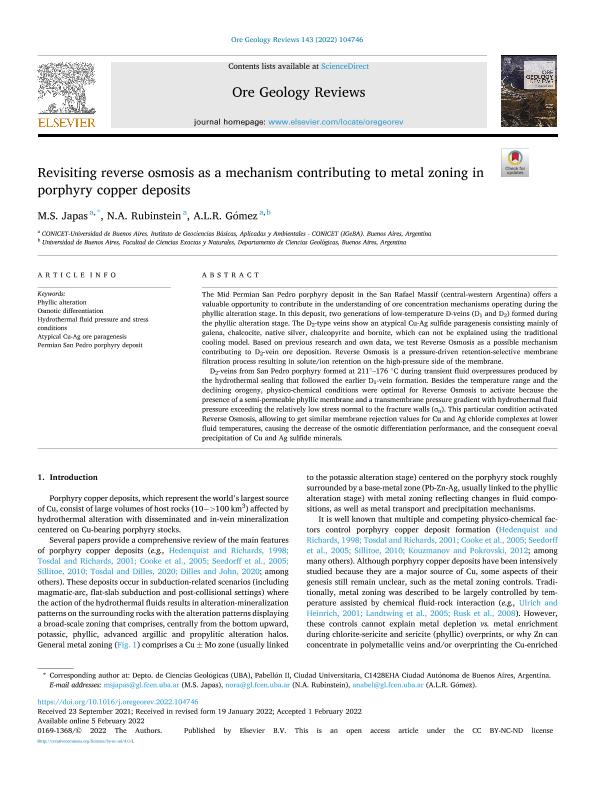Mostrar el registro sencillo del ítem
dc.contributor.author
Japas, Maria Silvia

dc.contributor.author
Rubinstein, Nora Alicia

dc.contributor.author
Gómez, Anabel

dc.date.available
2023-07-13T09:51:42Z
dc.date.issued
2022-04
dc.identifier.citation
Japas, Maria Silvia; Rubinstein, Nora Alicia; Gómez, Anabel; Revisiting reverse osmosis as a mechanism contributing to metal zoning in porphyry copper deposits; Elsevier; Ore Geology Reviews; 143; 4-2022; 1-17
dc.identifier.issn
0169-1368
dc.identifier.uri
http://hdl.handle.net/11336/203609
dc.description.abstract
The Mid Permian San Pedro porphyry deposit in the San Rafael Massif (central-western Argentina) offers a valuable opportunity to contribute in the understanding of ore concentration mechanisms operating during the phyllic alteration stage. In this deposit, two generations of low-temperature D-veins (D1 and D2) formed during the phyllic alteration stage. The D2-type veins show an atypical Cu-Ag sulfide paragenesis consisting mainly of galena, chalcocite, native silver, chalcopyrite and bornite, which can not be explained using the traditional cooling model. Based on previous research and own data, we test Reverse Osmosis as a possible mechanism contributing to D2-vein ore deposition. Reverse Osmosis is a pressure-driven retention-selective membrane filtration process resulting in solute/ion retention on the high-pressure side of the membrane. D2-veins from San Pedro porphyry formed at 211°–176 °C during transient fluid overpressures produced by the hydrothermal sealing that followed the earlier D1-vein formation. Besides the temperature range and the declining orogeny, physico-chemical conditions were optimal for Reverse Osmosis to activate because the presence of a semi-permeable phyllic membrane and a transmembrane pressure gradient with hydrothermal fluid pressure exceeding the relatively low stress normal to the fracture walls (σn). This particular condition activated Reverse Osmosis, allowing to get similar membrane rejection values for Cu and Ag chloride complexes at lower fluid temperatures, causing the decrease of the osmotic differentiation performance, and the consequent coeval precipitation of Cu and Ag sulfide minerals.
dc.format
application/pdf
dc.language.iso
eng
dc.publisher
Elsevier

dc.rights
info:eu-repo/semantics/openAccess
dc.rights.uri
https://creativecommons.org/licenses/by-nc-nd/2.5/ar/
dc.subject
ATYPICAL CU-AG ORE PARAGENESIS
dc.subject
HYDROTHERMAL FLUID PRESSURE AND STRESS CONDITIONS
dc.subject
OSMOTIC DIFFERENTIATION
dc.subject
PERMIAN SAN PEDRO PORPHYRY DEPOSIT
dc.subject
PHYLLIC ALTERATION
dc.subject.classification
Otras Ciencias de la Tierra y relacionadas con el Medio Ambiente

dc.subject.classification
Ciencias de la Tierra y relacionadas con el Medio Ambiente

dc.subject.classification
CIENCIAS NATURALES Y EXACTAS

dc.title
Revisiting reverse osmosis as a mechanism contributing to metal zoning in porphyry copper deposits
dc.type
info:eu-repo/semantics/article
dc.type
info:ar-repo/semantics/artículo
dc.type
info:eu-repo/semantics/publishedVersion
dc.date.updated
2023-07-05T12:32:41Z
dc.journal.volume
143
dc.journal.pagination
1-17
dc.journal.pais
Países Bajos

dc.journal.ciudad
Amsterdam
dc.description.fil
Fil: Japas, Maria Silvia. Consejo Nacional de Investigaciones Científicas y Técnicas. Oficina de Coordinación Administrativa Ciudad Universitaria. Instituto de Geociencias Básicas, Aplicadas y Ambientales de Buenos Aires. Universidad de Buenos Aires. Facultad de Ciencias Exactas y Naturales. Instituto de Geociencias Básicas, Aplicadas y Ambientales de Buenos Aires; Argentina
dc.description.fil
Fil: Rubinstein, Nora Alicia. Consejo Nacional de Investigaciones Científicas y Técnicas. Oficina de Coordinación Administrativa Ciudad Universitaria. Instituto de Geociencias Básicas, Aplicadas y Ambientales de Buenos Aires. Universidad de Buenos Aires. Facultad de Ciencias Exactas y Naturales. Instituto de Geociencias Básicas, Aplicadas y Ambientales de Buenos Aires; Argentina
dc.description.fil
Fil: Gómez, Anabel. Consejo Nacional de Investigaciones Científicas y Técnicas. Oficina de Coordinación Administrativa Ciudad Universitaria. Instituto de Geociencias Básicas, Aplicadas y Ambientales de Buenos Aires. Universidad de Buenos Aires. Facultad de Ciencias Exactas y Naturales. Instituto de Geociencias Básicas, Aplicadas y Ambientales de Buenos Aires; Argentina
dc.journal.title
Ore Geology Reviews

dc.relation.alternativeid
info:eu-repo/semantics/altIdentifier/url/https://linkinghub.elsevier.com/retrieve/pii/S0169136822000543
dc.relation.alternativeid
info:eu-repo/semantics/altIdentifier/doi/http://dx.doi.org/10.1016/j.oregeorev.2022.104746
Archivos asociados
